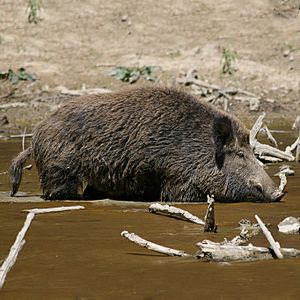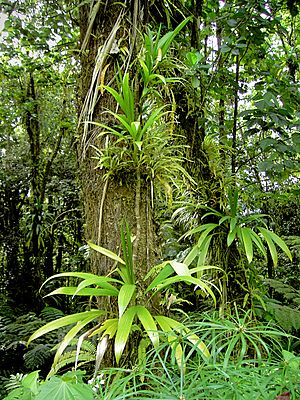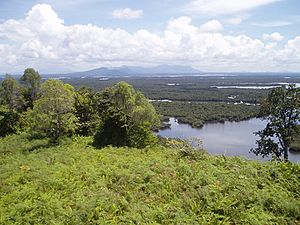Habitat facts for kids
A habitat is like a home for a specific type of animal, plant, or other living thing. It's the natural place where an organism lives, or the area that surrounds a group of them.
Contents
Animals and Their Homes
Most animals live in a certain type of environment because they are perfectly suited for it. We say they are 'adapted' to this environment. For example, frogs, newts, and ducks have webbed feet. These help them swim easily in water. There are many different kinds of habitats, and many different ways animals adapt to fit into each one.
When Habitats Change
If a habitat changes, it might not be a good home for the animals and plants anymore. Everything in nature is connected, so changes can have many effects. For example, Climate change is making some habitats warmer. This causes many animal species to move to cooler places.
However, some species cannot move. Their populations are getting smaller. Scientists believe that 10% of species might become extinct because of these changes. Other habitats have been cleared to make space for farms. In Australia, about 80% of the eucalypt forests have been cut down for farming over the last 210 years. This threatens forest animals like the koala.
Plants and Their Homes
Just like animals, plants also adapt to the places they live. Plants are found in many different habitats. Because of this, each plant has special features. Some plants are adapted to live on land, while others live in water.
Land Plants vs. Water Plants
Plants that grow on land usually have stiff stems. These stems help them stand upright. Water plants, however, tend to have softer stems. The water around them helps to support them.
Plants in Dry and Shaded Places
Plants that live in dry places, like the desert, have few or no leaves. Some, like cacti, can store water when it rains. Their special features help them lose less water. Plants that grow in shaded areas have large leaves. This helps them catch as much sunlight as possible. Some plants even climb towards the light.
Different Kinds of Habitats
There are many types of habitats around the world. Each one has its own climate, temperature, soil, and plants.
Land Habitats
Land habitats include forests, grasslands, wetlands, and deserts. Inside these large areas, there are even more specific habitats. These can have different weather, temperatures, soils, heights, and types of plants. Many of these habitats blend into each other. Each one has its own typical groups of plants and animals.
Freshwater Habitats
Freshwater habitats include rivers, streams, lakes, ponds, marshes, and bogs. Some living things can be found in most of these habitats. However, most have very specific needs. The speed of the water, its temperature, and how much oxygen it has are important. In rivers, there are fast and slow parts, deep pools, and quiet backwaters. These all offer different homes.
Water plants can float, be partly underwater, or be fully submerged. Some grow in wet soil next to water bodies. Plants along the edges of water provide important homes for small creatures and larger animals. Plants underwater add oxygen to the water. They also soak up nutrients and help reduce pollution.
Ocean Habitats
Ocean habitats include salty water, river mouths (estuaries), bays, the open sea, and the areas where land meets the sea (intertidal zone). They also include the sea floor, reefs, and deep or shallow water areas. Other variations are rock pools, sand banks, mudflats, salty lagoons, sandy and pebbly beaches, and seagrass beds. All of these support their own plants and animals.
The benthic zone, or seabed, is home to creatures that stay in one place, attached to the bottom. It also has many creatures that crawl on or dig into the surface. Some creatures float on the waves or on floating debris. Others swim at different depths. This includes creatures near the seabed and tiny organisms that drift with the currents, called plankton.
Desert Habitats
A desert is a tough habitat for amphibians. Amphibians need water to keep their skin moist and for their young to grow. Still, some frogs live in deserts! They create moist homes underground. They also hibernate when conditions are bad.
For example, the Couch's spadefoot toad comes out of its burrow when it rains heavily. It lays its eggs in the temporary pools that form. The tadpoles grow very quickly, sometimes in as little as nine days. They then change into frogs and eat a lot before digging their own burrows.
Temporary Water Habitats
Other living things deal with their watery homes drying up in different ways. Vernal pools are temporary ponds that form in the rainy season and dry up later. They have special plants, mostly annuals, whose seeds survive the dry period. Some unique perennial plants also live there.
Animals adapted to these extreme habitats also exist. Fairy shrimps can lay "winter eggs" that can survive drying out. These eggs can sometimes be blown around with dust and end up in new puddles. They can stay dormant for up to fifteen years! Some killifish act similarly. Their eggs hatch and the young fish grow very fast when conditions are right. But the whole fish population might end up as eggs in a resting state in the dried mud that was once a pond.
City Habitats
Many animals and plants have made cities their homes. They tend to be adaptable and use the city's features to build their homes. Rats and mice have followed humans all over the world. Pigeons, peregrines, sparrows, swallows, and house martins use buildings for nesting. Bats use roof spaces for sleeping. Foxes visit garbage bins. Squirrels, coyotes, raccoons, and skunks roam the streets. About 2,000 coyotes are thought to live in and around Chicago.
A study of houses in northern European cities found about 175 types of small creatures inside them. These included 53 types of beetles, 21 flies, 13 butterflies and moths, 13 mites, 9 lice, 7 bees, 5 wasps, 5 cockroaches, 5 spiders, and 4 ants. In warmer places, termites are a big problem in cities. 183 species are known to affect buildings, and 83 species cause serious damage to structures.
Related pages
Images for kids
-
This coral reef in the Phoenix Islands Protected Area provides habitat for numerous marine species.
-
Few creatures make the ice shelves of Antarctica their habitat, but water beneath the ice can provide habitat for multiple species. Animals such as penguins have adapted to live in very cold conditions.
-
Twenty five years after the devastating eruption at Mount St. Helens, United States, pioneer species have moved in.
See also
 In Spanish: Hábitat para niños
In Spanish: Hábitat para niños










